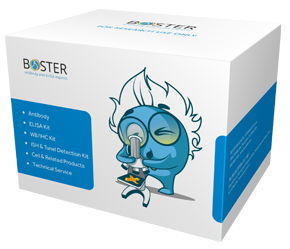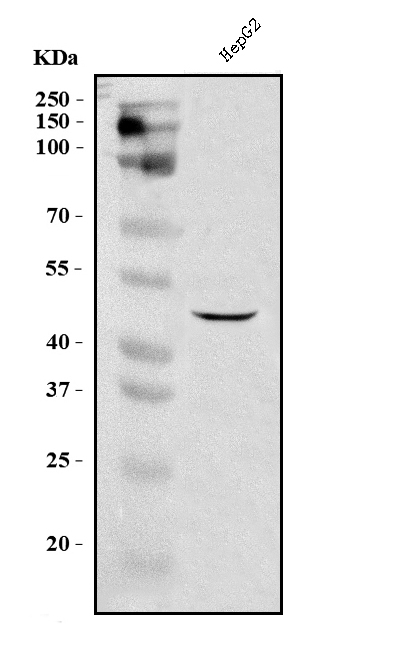Product Info Summary
| SKU: | A01025-Dyl488 |
|---|---|
| Size: | 100 μg/vial |
| Reactive Species: | Human |
| Host: | Rabbit |
| Application: | Flow Cytometry |
Customers Who Bought This Also Bought
Product info
Product Name
Anti-Human DC-SIGN DyLight® 488 conjugated CD209 Antibody
SKU/Catalog Number
A01025-Dyl488
Size
100 μg/vial
Form
Liquid
Description
Boster Bio Anti-Human DC-SIGN DyLight® 488 conjugated CD209 Antibody catalog # A01025-Dyl488. Tested in Flow Cytometry applications. This antibody reacts with Human.
Storage & Handling
At -20°C for one year from date of receipt. Avoid repeated freezing and thawing. Protect from light.
Cite This Product
Anti-Human DC-SIGN DyLight® 488 conjugated CD209 Antibody (Boster Biological Technology, Pleasanton CA, USA, Catalog # A01025-Dyl488)
Host
Rabbit
Contents
Each vial contains 50% glycerol, 0.9% NaCl, 0.2% Na2HPO4, 0.02% NaN3.
Clonality
Polyclonal
Isotype
Rabbit IgG
Immunogen
A synthetic peptide corresponding to a sequence at the N-terminus of human DC-SIGN.
*Blocking peptide can be purchased. Costs vary based on immunogen length. Contact us for pricing.
Cross-reactivity
No cross-reactivity with other proteins.
Reactive Species
A01025-Dyl488 is reactive to CD209 in Human
Reconstitution
Observed Molecular Weight
39 kDa
Calculated molecular weight
45.775kDa
Background of CD209
DC-SIGN (Dendritic Cell-Specific Intercellular adhesion molecule-3-Grabbing Non-integrin) also known as CD209 (Cluster of Differentiation 209) is a protein which in humans is encoded by the CD209 gene. This gene encodes a transmembrane receptor and is often referred to as DC-SIGN because of its expression on the surface of dendritic cells and macrophages. The encoded protein is involved in the innate immune system and recognizes numerous evolutionarily divergent pathogens ranging from parasites to viruses with a large impact on public health. The protein is organized into three distinct domains: an N-terminal transmembrane domain, a tandem-repeat neck domain and C-type lectin carbohydrate recognition domain. The extracellular region consisting of the C-type lectin and neck domains has a dual function as a pathogen recognition receptor and a cell adhesion receptor by binding carbohydrate ligands on the surface of microbes and endogenous cells. The neck region is important for homo-oligomerization which allows the receptor to bind multivalent ligands with high avidity. Variations in the number of 23 amino acid repeats in the neck domain of this protein are rare but have a significant impact on ligand binding ability. This gene is closely related in terms of both sequence and function to a neighboring gene. DC-SIGN and L-SIGN differ in their ligand-binding properties and distribution. Alternative splicing results in multiple variants.
Antibody Validation
Boster validates all antibodies on WB, IHC, ICC, Immunofluorescence, and ELISA with known positive control and negative samples to ensure specificity and high affinity, including thorough antibody incubations.
Application & Images
Applications
A01025-Dyl488 is guaranteed for Flow Cytometry Boster Guarantee
Assay Dilutions Recommendation
The recommendations below provide a starting point for assay optimization. The actual working concentration varies and should be decided by the user.
Flow Cytometry (Fixed), 1-3μg/1x106 cells
Validation Images & Assay Conditions

Click image to see more details
Boster Kit Box
Protein Target Info & Infographic
Gene/Protein Information For CD209 (Source: Uniprot.org, NCBI)
Gene Name
CD209
Full Name
CD209 antigen
Weight
45.775kDa
Alternative Names
CD209 antigen; C-type lectin domain family 4 member L; Dendritic cell-specific ICAM-3-grabbing non-integrin 1; DC-SIGN; DC-SIGN1; CD209; CD209; CLEC4L CD209 CDSIGN, CLEC4L, DC-SIGN, DC-SIGN1 CD209 molecule CD209 |C-type lectin domain family 4 member L|HIV gpl20-binding protein|dendritic cell-specific ICAM-3-grabbing non-integrin 1|dendritic cell-specific intercellular adhesion molecule-3-grabbing non-integrin|dendritic cell-specific intracellular adhesion molecules (ICAM)-3 grabbing non-integrin
*If product is indicated to react with multiple species, protein info is based on the gene entry specified above in "Species".For more info on CD209, check out the CD209 Infographic

We have 30,000+ of these available, one for each gene! Check them out.
In this infographic, you will see the following information for CD209: database IDs, superfamily, protein function, synonyms, molecular weight, chromosomal locations, tissues of expression, subcellular locations, post-translational modifications, and related diseases, research areas & pathways. If you want to see more information included, or would like to contribute to it and be acknowledged, please contact [email protected].
Specific Publications For Anti-Human DC-SIGN DyLight® 488 conjugated CD209 Antibody (A01025-Dyl488)
Hello CJ!
No publications found for A01025-Dyl488
*Do you have publications using this product? Share with us and receive a reward. Ask us for more details.
Recommended Resources
Here are featured tools and databases that you might find useful.
- Boster's Pathways Library
- Protein Databases
- Bioscience Research Protocol Resources
- Data Processing & Analysis Software
- Photo Editing Software
- Scientific Literature Resources
- Research Paper Management Tools
- Molecular Biology Software
- Primer Design Tools
- Bioinformatics Tools
- Phylogenetic Tree Analysis
Customer Reviews
Have you used Anti-Human DC-SIGN DyLight® 488 conjugated CD209 Antibody?
Submit a review and receive an Amazon gift card.
- $30 for a review with an image
0 Reviews For Anti-Human DC-SIGN DyLight® 488 conjugated CD209 Antibody
Customer Q&As
Have a question?
Find answers in Q&As, reviews.
Can't find your answer?
Submit your question
3 Customer Q&As for Anti-Human DC-SIGN DyLight® 488 conjugated CD209 Antibody
Question
We have seen staining in human placenta. Any tips? Is anti-Human DC-SIGN DyLight® 488 conjugated antibody supposed to stain placenta positively?
Verified Customer
Verified customer
Asked: 2019-09-09
Answer
Based on literature placenta does express CD209. Based on Uniprot.org, CD209 is expressed in adrenal gland, placenta, uterus, among other tissues. Regarding which tissues have CD209 expression, here are a few articles citing expression in various tissues:
Placenta, Pubmed ID: 1518869
Uterus, Pubmed ID: 14702039
Boster Scientific Support
Answered: 2019-09-09
Question
Our team were satisfied with the WB result of your anti-Human DC-SIGN DyLight® 488 conjugated antibody. However we have been able to see positive staining in placenta isoform 1: cell membrane using this antibody. Is that expected? Could you tell me where is CD209 supposed to be expressed?
Verified Customer
Verified customer
Asked: 2019-08-27
Answer
From what I have seen in literature, placenta does express CD209. Generally CD209 expresses in isoform 1: cell membrane. Regarding which tissues have CD209 expression, here are a few articles citing expression in various tissues:
Placenta, Pubmed ID: 1518869
Uterus, Pubmed ID: 14702039
Boster Scientific Support
Answered: 2019-08-27
Question
We are currently using anti-Human DC-SIGN DyLight® 488 conjugated antibody A01025-Dyl488 for human tissue, and we are satisfied with the Flow Cytometry results. The species of reactivity given in the datasheet says human. Is it true that the antibody can work on dog tissues as well?
Verified Customer
Verified customer
Asked: 2019-06-06
Answer
The anti-Human DC-SIGN DyLight® 488 conjugated antibody (A01025-Dyl488) has not been validated for cross reactivity specifically with dog tissues, but there is a good chance of cross reactivity. We have an innovator award program that if you test this antibody and show it works in dog you can get your next antibody for free. Please contact me if I can help you with anything.
Boster Scientific Support
Answered: 2019-06-06




